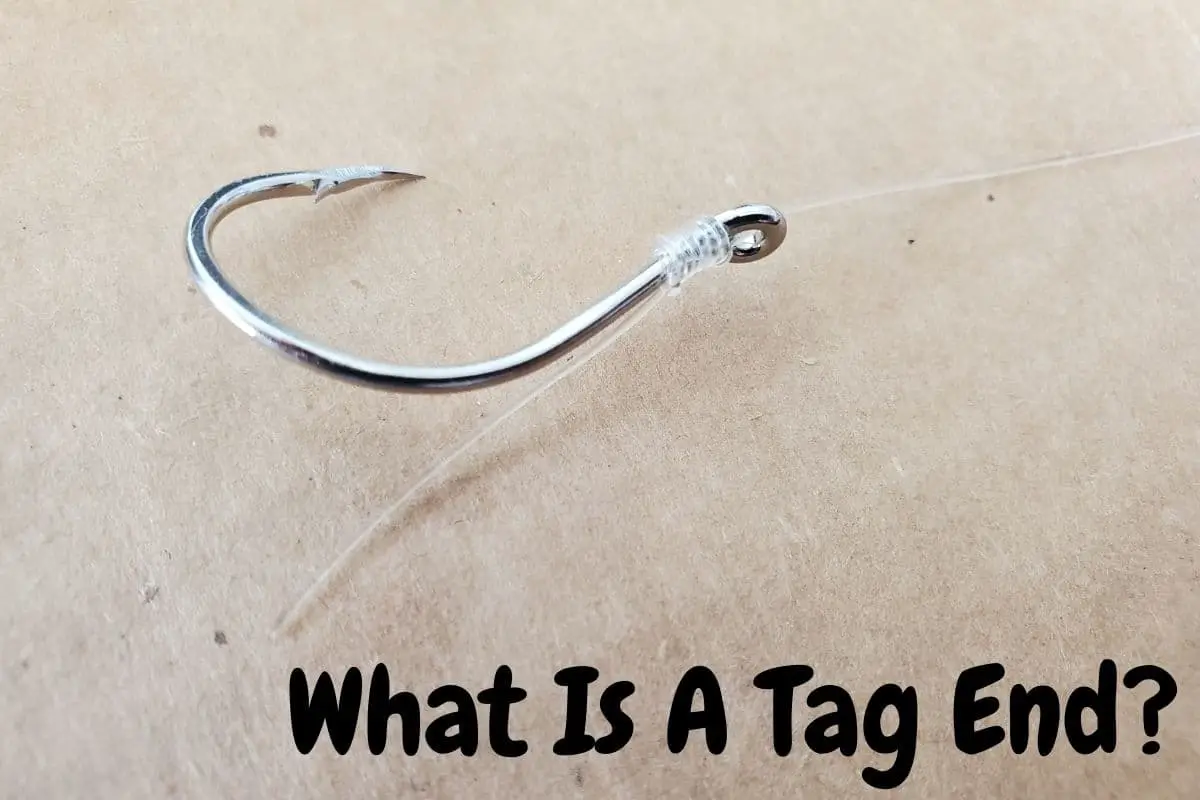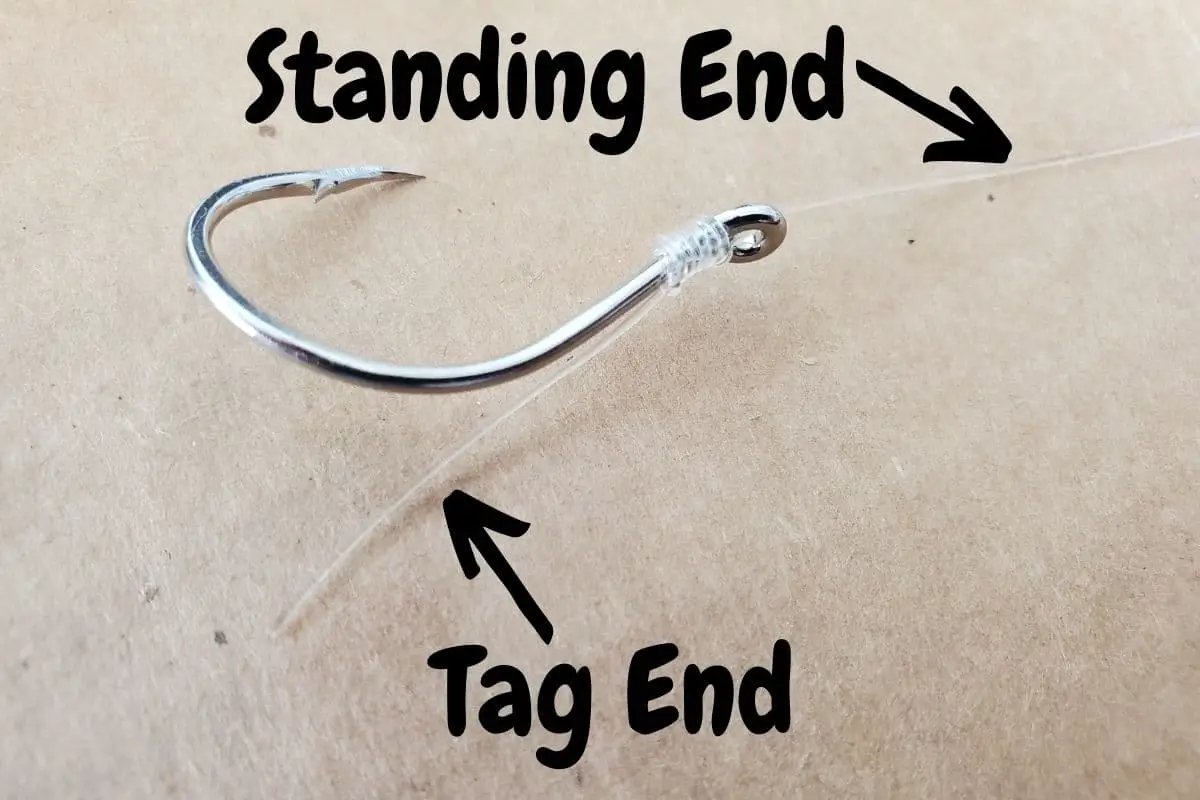
If you are a new angler, you are probably learning a few knot tying techniques to attach your lures, hooks, and other paraphernalia to your fishing line. Knot tying tutorials will often use terminology such as tag end, which you may not be familiar with.
A fishing line tag end is the loose end of the fishing line and is sometimes referred to as the working end in knot tying terminology. The opposite side of the line connected to the fishing reel is called the standing end. Knot tying uses these terms to differentiate between the two ends of the line.
Knot tying is a necessary skill to master for all anglers, and the better your knowledge of knots and their applications in fishing, the less frustrated you will be. The tag end of a knot is important to understand from a terminology point of view and a knot structure aspect. If your knots are constantly pulling loose, you may be having trouble with your tag end.
Why Is The Tag End Of Your Fishing Line Important?
Most anglers who have been fishing for some time have a handful of knots that they prefer you use as their go-to knots. As a new angler, you still need to get your head around these knots and figure out which ones will work for you. The tag end of your knots can have a surprising influence on the quality of your knot tying for fishing.
The tag end or working end of your fishing line is the loose end used in tying knots in your line. The tag end is important because it can influence the success and security of the final knot. Knots slipping loose or line breaking at the knot can result from a tag end not being treated right.
Most anglers are aware that the tag end should be trimmed after the knot is tied to prevent excess line flapping around behind the knot. Trimming the tag end requires some explanation so that this part of the knot does not become a source of frustration.

How Long Should Your Tag End Be After Trimming It?
Once you have tied the knot in your fishing line, it is time to tidy up the knot and trim off the excess on the tag end of the line. How long should you trim the tag end? Should you trim it tight on the knot or leave a short length?
The length of the tag end after trimming it can vary depending on the knot being tied. Generally, the tag end should be trimmed, so 1/16 of an inch to 1/8 of an inch protrudes from the knot. Cutting the tag end too short may allow the tag end to slip through the knot.
Trimming the tag end of the knot down to these sizes should be more than sufficient to prevent the tag end from slipping through the knot and causing the entire knot to unravel. If you trim your tag ends to this length, and you are still experiencing pull-through, the problem probably lies with your knot tying rather than the length of the tag end.
Anglers experiencing pull-through of the tag end on their knots may be tempted to leave the tag end long to compensate for this problem. A long tag end can lead to additional complications for your fishing.
Any Down Sides With having A Longer Tag End?
Some new anglers having trouble with their knots, or simply because they do not know any better, may simply leave a long tag end on their fishing knots. This can be as problematic for your fishing as cutting the tag end too short.
Leaving a long tag end on your fishing knots can add additional weight to the knot, increase drag in the water, affect the behaviour of the lure in the water, increase the risk of getting tangles in obstacles and even distract the fish from striking your bait.
Fishing line may be light, but a long tag end can add extra weight to the side of the knot, causing the knot to twist in the water.
Likewise, if you use cast and retrieve lures, the longer tag end will increase the drag on the line. The additional drag can affect the lure’s movement in the water and prevent it from performing as it should.
A longer tag end can increase the risk of snagging your line on obstacles in the water, and it can increase the visibility of your line in the water. The additional visibility may disturb fish and discourage them from biting, especially if you target a wary species.
What You Can Use To Cut Your Tag End
Trimming the tag end is one thing but using the right tool to trim your fishing line tag end is equally important. Using the wrong tool on the wrong type of line can compromise the tag end, affecting the integrity of the knot.
Monofilament and fluorocarbon lines are the easiest lines to cut, and a small pair of wire cutters, fishing line scissors, or even a sharp knife will work well to cut these lines cleanly.
Braided line is the type of fishing line that is difficult to cut cleanly. A tool that is not sharp will leave a mess of frayed ends that could damage the tag end when you trim it down.
Some specialized fishing shears are designed to cut all types of fishing line, including braided line. The SAMSFX Fishing Braid Line Shears is an example of a good pair of fishing scissors that can cut all types of fishing line.
One of the most compact and useful line cutting tools that also slices through braided line like butter is the Boomerang Tool Company’s SNIP line cutting tool. It comes with an integrated retractable tether to clip it to your PFD and stainless steel blades capable of cutting cleanly through any type of fishing line.
Tips When Making Knots To Avoid The Tag End From Slipping Through The Knot
As we have already intimated, if you are having trouble with the tag end of your knots pulling through, the problem may be with your knot tying technique rather than the length of the tag end.
Here are a few angling tips to help you with your knot tying to prevent the tag end from pulling through.
- Cinch the knot down properly. One of the primary causes of knots fishing knots coming loose or tag ends pulling through the knot is because the knot is not tightened down properly. You need to focus on really tightening down the knot, even using a pair of needle-nose pliers to get the job done thoroughly. A tight knot will prevent the tag end from having enough slack to slip through.
- Lubricate your knots before tightening. Lubricating the knot before tightening it down will prevent the line from binding on itself as you tighten the knot. Many anglers use a squirt of WD-40 on the knot as lubrication.
- Choose the right knot for the line type. Some knots work better on monofilament lines but not so well on braided line and vice versa. Likewise, some braided line knots will not work well on fluorocarbon lines. Get to know the line you are using and the best knots to use on that type of line to prevent knot failures and tag ends slipping through.
Tag Ends Are A Small But Important Part Of A Knot
The tag end of the knot may seem insignificant since it is the leftover part of the line after completing the knot.
Incorrect treatment of the tag end can have consequences to your fishing and result in frustrations in the form of lost lures and lost fish.
Pay close attention to the construction of the knot, tightening the knot down properly, and trimming the tag end to the appropriate length, and your tag end problems should be a thing of the past.
Conclusion
Fishing is a complex hobby with many technical aspects to master. One of the primary aspects to concentrate on improving is your knot tying.
This will reduce the frustration of lost lures and lost fish on the line and contribute to making you a better angler! Part of improving your knot tying is giving the tag end the attention it needs to prevent it from becoming a bugbear for your fishing!
Happy Fishing and Tight Lines
